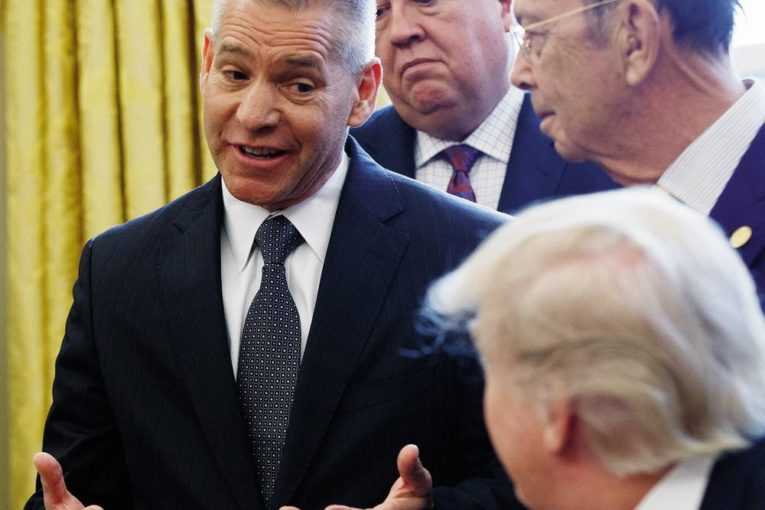
TransCanada Corp. walked away from the mammoth Energy East pipeline project due to its “complexity and difficulty.”
But the pipeline giant will keep moving ahead with its Keystone XL project due to the strong economics underpinning the project.
Company CEO Russ Girling didn’t drop any bombshells Thursday speaking at a CIBC investor conference in Whistler, but gave some clarity to two of the most critical pipeline decisions facing the country’s energy sector in recent years.
In doing so, he provided insight into the daunting obstacle course that now stands in front of future energy developments in Canada. Even in a world of “no brainers” — as Stephen Harper once called Keystone XL approval — nothing should be taken for granted, and caution will loom over future decisions.
“We are committed to moving this project forward but … we’ve got a lot of bruises of not being really careful,” Girling said about Keystone XL.
“So we will just be really careful about how we spend our money through the next 12 months.”
If built, the US$8-billion project will help get Alberta crude south to U.S. Gulf Coast refiners. It’s desperately needed by Western Canadian producers who are facing steep discounts today for their oil.
A decade in the making, the proposed pipeline from the Hardisty area to Steele City, Neb., was resurrected last year after the Trump White House granted it a presidential permit, something that had been denied by the previous Obama administration.
After Nebraska regulators approved the pipeline route in November — although they didn’t choose the company’s preferred path — the last big obstacle was locking up shippers to use the line, something it accomplished last week.
Yet, the company didn’t proclaim a final investment decision for the project.
On Thursday, Girling stopped short of giving Keystone XL the official green light, but left little doubt work is proceeding, money is being spent and the economics make sense.
“By the end of the year, we will be in a position to start construction in 2019,” he said. “We’ve been at this for close to 10 years and the market demand is still there for the project.”
But it’s not a done deal just yet.
Unhappy landowners have filed an appeal of the approval by the Nebraska Public Service Commission. Environmental opponents vow to keep fighting the cross-border development.
The Calgary-based company is taking a cautious approach moving forward, something we’ve also heard from Kinder Morgan recently in building the Trans Mountain pipeline expansion to the B.C. coast.
In the case of Keystone, Girling said the company will prudently spend money in the coming months to acquire land along the right of way, obtain permits and complete engineering work.
The alternate route in Nebraska will add another $100 million to $200 million to the price-tag, although that doesn’t appear to be a show-stopper.
And the CEO said TransCanada will be “far more methodical today” about how it would define and make a final investment decision around the large-scale development.
Former TransCanada executive Dennis McConaghy said the company could still face some unforeseen legal issues in the United States, but it seems committed to keeping the project on track.
“It’s like he virtually said TransCanada has made a final investment decision, other than actually calling it a final investment decision,” McConaghy said of Girling.
Kevin Birn, an analyst with IHS Markit, said the Canadian energy sector clearly needs additional pipeline capacity, but the caution shown by developers reflects the level of uncertainty around getting such projects finished.
“You don’t want to hit snags in the middle of the way that cost you more money,” he said.
For Canadian petroleum producers, a positive decision to build Keystone XL is essential, as oilsands output continues to increase, pipelines are full and more oil is moving by trains.
The differential between the Western Canadian Select heavy oil benchmark and West Texas Intermediate crude has widened in the past two months, sitting at almost US$28 a barrel on Wednesday after averaging $11 in November.
Building new pipelines, including Keystone, Trans Mountain and Enbridge’s Line 3 project, will be imperative to improving the economics for the Canadian oilpatch.
Yet, completing new oil and gas pipelines won’t be easy, as the demise of the $15.7-billion Energy East project demonstrates.
Last October, TransCanada pulled the plug on the pipeline, which would have shipped oil from Alberta and Saskatchewan to the Atlantic coast.
Federal officials and some analysts blamed commercial factors for undermining its economics, but a decision by the National Energy Board to consider the project’s upstream and downstream greenhouse gas emissions added another layer of complication.
Girling didn’t cite economics Thursday as the reason the project was terminated. Asked why Energy East was shelved, he talked about the “complexity and the difficulty.
“We have many opportunities in our portfolio that are far less complex, far more real and far more doable. And we had to make a hard decision,” he said.
“I still believe that Energy East is a great idea for this nation, but it didn’t appear that we could get all of the pieces put together that were necessary.”
In order words, there were so many hurdles in its path, it wasn’t worthwhile to spend more money, time and effort on a project it wasn’t certain could survive all of the potential pitfalls.
And that’s the dicey dilemma facing Canadian energy development.
Does the country really want to expand fossil fuel production in the years ahead, and can it do so successfully in an era of decarbonization?
These are hard questions and the debate is complex.
Until there’s some clarity to this conundrum, however, caution will remain a guiding principle for companies like TransCanada trying to build important energy projects like Keystone XL.
Chris Varcoe is a Calgary Herald columnist.
You can read more of the news on source
